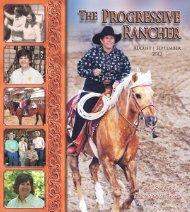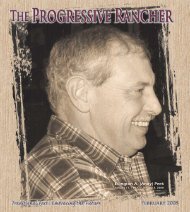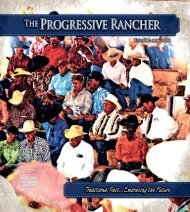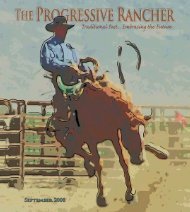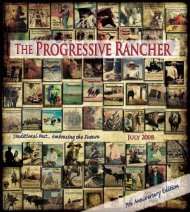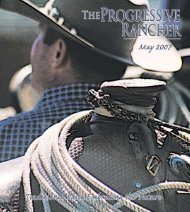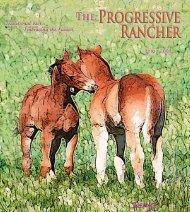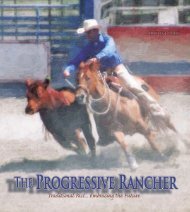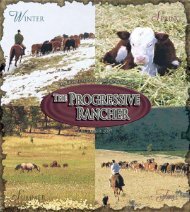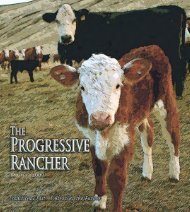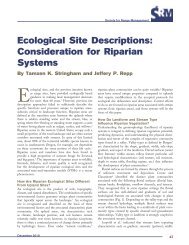fallon Bull Sale - The Progressive Rancher Magazine
fallon Bull Sale - The Progressive Rancher Magazine
fallon Bull Sale - The Progressive Rancher Magazine
Create successful ePaper yourself
Turn your PDF publications into a flip-book with our unique Google optimized e-Paper software.
DR. Margaret, Ph.D.<br />
208-308-0106<br />
Dr. Margaret Winsryg, Ph.D. 208-308-0106 MNM Consulting Services<br />
Why We Feed Different Protein Sources to Our Horses?<br />
<strong>The</strong> protein needs of the horse vary according to use and age. <strong>The</strong> table below<br />
gives the minimum level needed for various types of horses. From the table<br />
it can be seen that protein needs are greatest for foals and for lactating mares. Work<br />
does not increase protein needs very much but does increase certain amino acids<br />
needs. For example, if we were feeding 18 lb. of a ration that is 13% protein to a mature<br />
horse and if we begin riding the horse hard, we would maintain a 13% protein level,<br />
but increase the total amount of feed (20 lb.) used to maintain the horse in good flesh.<br />
This would also increase the total amount of protein<br />
given and be sufficient to meet extra protein needs<br />
caused by work.<br />
Proteins are the building blocks of tissue and are<br />
composed of units called amino acids. Although there<br />
are 22 different amino acids that are needed for protein<br />
synthesis, several can be made by the tissues of the body.<br />
<strong>The</strong>re are 10 that must be supplied to the horse – arginine,<br />
histidine, isoleucine, leucine, lysine, methionine, phenylalanine,<br />
threonine, tryptophan, and valine. Lysine is the<br />
one most often lacking in growing horse rations<br />
Because of the high cost of protein, it is economically<br />
wasteful to feed more than is needed. <strong>The</strong> body breaks<br />
down excess protein to carbohydrates and urea. <strong>The</strong><br />
carbohydrates are used for energy or changed to fat and<br />
stored, and the urea is passed in the urine.<br />
It was previously mentioned that urea is a feed<br />
supplement fed by cattle feeders that a cow can use to<br />
make protein in the rumen. Horses cannot use urea as a<br />
protein source, and feeds with their protein level based on<br />
urea will not reflect an accurate protein level for the horse.<br />
In addition to cost, another possible detriment of excess<br />
protein is that it produces more body heat in breaking<br />
the proteins into energy as compared to using carbohydrates<br />
or fats for energy. This could be a problem for the<br />
endurance trail horse that has to keep as cool as possible as he works long and hard. Current<br />
research has shown that feeding a diet containing 10% added fat reduces the daily heat load<br />
by 5%, which may benefit hard working horses, particularly in hot weather. <strong>The</strong>refore, high<br />
protein rations are not recommended for these horses.<br />
Occasionally horses will develop hives, commonly called protein bumps, on the skin.<br />
<strong>The</strong>se can be an allergic reaction of the body to foreign proteins in the feed but are more<br />
likely are the result of skin contact with some chemical in the bedding. Insect bites also<br />
cause these hives. Generally, the hives are short lived and no serious problem occurs.<br />
High protein rations have also been blamed for the diseases such as epiphysitis and<br />
contracted tendons. <strong>The</strong>se problems are associated with fast-growing foals, as these foals<br />
are typically on high-protein high-energy rations that allow the foal to grow quickly. However,<br />
it is the imbalance or deficiency of other factors such as minerals that are the real<br />
culprits, not the protein.<br />
Plant Protein Supplements<br />
<strong>The</strong>se are basically the high-protein parts of grains that have had the oil removed for<br />
use in other industries.<br />
Soybean Meal<br />
This oil meal has the highest biological value and has a 44% to 48% protein content<br />
on an as-fed basis. <strong>The</strong> quality (biological value) of a protein supplement is based on a<br />
comparison of the amino acids that make up soybean protein to the amino acids required<br />
by the horse to make up his proteins. Not only do they need to have the same amino acids,<br />
Table. Minimum Crude Protein Requirement<br />
(Percent in Ration).<br />
but they should be present in the same relative percentages. Soybean meal is especially high<br />
in lysine, which is commonly low in most grains. Soybean meal is also usually the cheapest<br />
source of protein per unit of protein available for horse feeds.<br />
Soybeans should not be fed to horses in their raw form. In the raw form they contain<br />
an inhibitor of protein digestion in the horse. Raw soybeans are especially detrimental in<br />
foal rations.<br />
% In<br />
Ration<br />
% of Live Wt.<br />
Fed/Day*<br />
Mature idle horse 14.0 1.5<br />
Pregnancy (last 90 14.5 1.5<br />
days)<br />
Lactation (first 4 mos.) 14.5 2.0<br />
Foals (creep feed, 18.0 2.8<br />
nursing)<br />
Weanlings 16.0 2.3<br />
Yearlings (12 mos.) 14.0 1.9<br />
Yearlings (18 mos.) 13.0 1.7<br />
Two year olds 13.0 1.5<br />
* Percent of live weight fed is based on moisture-free<br />
feed. Actual percent of weight eaten will be higher on<br />
an as-fed basis. Also, if the horse eats more or less than<br />
this percent of its weight per day in moisture-free feed,<br />
the percent needs to be adjusted accordingly.<br />
Linseed Meal<br />
Linseed meal used to be in great demand for inclusion<br />
in feed rations for horses. This meal is high in sulfur-containing<br />
amino acids, which were thought to aid the quality<br />
of the hair coat. Actually, the quality of the hair coat came<br />
more from the oil in the meal. However, modern processing<br />
removes most of the oil, thereby decreasing its value<br />
for horse feeding. Linseed meal is about 35% protein as<br />
fed, costs more, and has a lower biological value than soybean<br />
oil meal. Linseed has been recommended in rations<br />
of horses that suffer from tying-up syndrome, because it is<br />
a good source of selenium, which helps maintain normal<br />
muscle function.<br />
Cottonseed Meal<br />
Cottonseed meal contains about 39% protein on an<br />
as-fed basis and is second to soybean oil meal in quality. If<br />
it is available and cost effective, it may be used for horses.<br />
Cottonseed meal contains a substance called gossypol that<br />
interferes with digestion and is particularly undesirable<br />
for feeding foals. Adult horses can tolerate the gossypol.<br />
Research in other species has shown cottonseed oil meal<br />
to decrease sperm production in males, and this effect is<br />
thought to occur in stallions, too.<br />
Other Sources<br />
Other protein sources such as sunflower and canola<br />
meals can be used in horse feeds. Also, brewers grains, distillers grains, and gluten are<br />
commonly used in horse feeds as protein sources.<br />
Animal Protein Supplements<br />
Animal protein supplements such as meat scraps or blood meal are not used in today’s<br />
feeds.<br />
Dr. Margaret Winsryg<br />
MNM Consulting<br />
Equine & Bovine Nutrition<br />
(208) 308-0106<br />
3290 N 2200 E, Twin Falls, ID 83301<br />
www.progressiverancher.com <strong>The</strong> <strong>Progressive</strong> <strong>Rancher</strong><br />
February 2011 35



